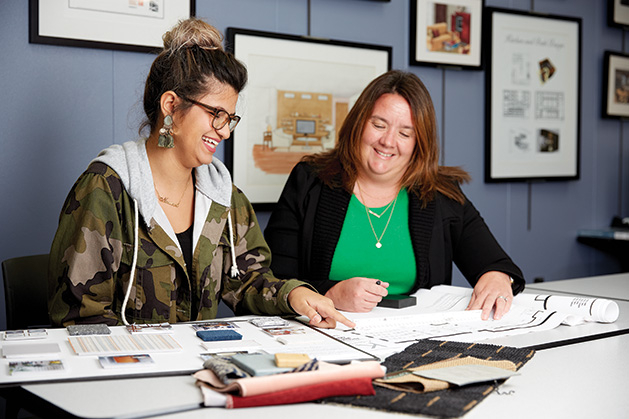
"I grew up in a family that was flipping houses before HGTV was even invented," says Sarah Rodriguez, professor and program director of interior design at White Bear Lake’s Century College.
Rodriguez’s dad flipped four houses before Rodriguez left University of Wisconsin-Madison, where she, without a second thought, enrolled in a course in design and color. After all, she’d grown up in a world where piles of paint chips and flooring samples were as much a part of the household as cups or shoes. That class inspired her to earn a bachelor’s degree in interior design and launch a career in New York before taking the helm of the interior design program at Century. Certified by the American Institute of Interior Designers (ASID), she also owns her own design company, Skogstrom Rodriguez, and brings her real-world design and entrepreneurial experience into the classroom.
At Century, interior design students begin with technical courses, getting an overview of historical design trends and vocabulary in courses like Furniture Styles and Periods, Lighting Fundamentals, Design and Color, and Textile Application. Then things get a little more hands-on, with studio and presentation skills courses, an internship and portfolio compilation.
All along the way, assignments are practical and open-ended, designed to allow students to take a design from concept to completion, considering real-world time, supply and budget limitations of each project. “Sometimes we work with an empty loft floor plan and they need to get the kitchen, bedrooms, bathrooms, office and more to fit. It gets your brain thinking,” says Rodriguez. Students also go out, guided by an instructor, to select all of the appliances, furniture, fabrics, lighting and art for a home. “This practicum gives real-world experience so they are ready for the industry,” Rodriguez says.

Century has an ASID student chapter—giving students exposure to the professional world, and students are encouraged to travel both domestically and abroad to tour design companies, observe lifestyles and trends from different cultures, and broaden their perspectives. “We encourage students to be engaged with other cultures and design ideas as we are becoming a more globally-enriched community,” Rodriguez says. As students learn to select materials that will bring the right feel and functionality to a space, they’re taught to think in terms of not just preference and function, but also responsibility and longevity.
“People are beginning to live with less, and it takes a good designer to help people pare down and live in a smaller space. Designs are trending toward items made locally and with recycled materials, and items that will stand the test of time,” Rodriguez says.
As always, designers must be well-read and keep an eye on trends, incorporating the newest materials and popular colors and textures. But there’s a growing focus in the industry, at Century and in homes across America on sustainability and practicality. Spaces are mindfully created with real clients in mind. They’re intentional, edited down and unique to the lifestyle and life stage of the people who will live there. And as Century prepares a new generation of designers for this shifting industry, diversity is celebrated. The hope is that a more diverse design community can better serve clientele in every culture, economic background and lifestyle. “Our students are from all areas of the world and all ages. We all need good interior designers,” Rodriguez says.
The Lodge by Bear Trap Design
Soon after Michael and Tami Holsten bought their 13-acre former farm parcel in Grant, they realized, “We’re log cabin people. We’re outside people,” says Tami. She acted as general contractor for the home that would transform her family’s lifestyle, as well as her career. As the story goes, family and friends—and eventually friends of friends—walked through the home and began offering Tami design-related jobs. The attention inspired her to return to school and shift her career path from athletic training and equipment sales to home design. She returned to school, choosing the Century College Interior Design and Kitchen and Bath Design programs because of the convenient location and affordability. “This home is truly a reflection of who we are. Design just found me,” Tami says.
The home was finished in 2002—around the same time Holsten launched her own business, Bear Trap Design—and features attention-grabbing, hand-scraped logs visible indoors and out. Visitors are wowed from the moment they enter the Holstens’ driveway—Christmas lights and fun outdoor statement pieces abound. One year, luminaries lined the gravel driveway and welcomed party guests. A wraparound porch frames a gigantic custom front door—decked with a fresh, oversized magnolia wreath and matching garland and an antique sleigh and toboggan. There’s a 7-foot-tall wooden bear statue, a gift from Tami to Michael, that's adorned with cheeky seasonal accessories. Inside is an ever-changing wonderland of antiques Tami has collected, mixed with a little glam and loads of fresh greenery. Especially during the holidays, old meets new and rustic meets refined in the best possible way. The Holsten home—and Tami’s unique eye for design—were featured in the December 2017 issue of St. Croix Valley magazine.
Century College Interior Design by the numbers
100
Students in the program.
4
Hours in a typical weekly class “We have longer classes so students can work and faculty can really work with students,” says Rodriguez.
60
Credits in the Interior Design associate degree program, which can be taken full- or part-time, with a mix of daytime, evening and online courses.
3
Dedicated instructors, including Rodriguez, Sheree Vincent of Fusion Design and Catherine Harrington of Catherine Harrington Designs.
916
Area Vocational Technical Institute—Century’s name in the late 1960s when the school—and its interior design program—were launched. Interior design was a completely different world, studded with orange walls and Eames chairs. “The industry has changed over the years with the birth of the Internet,” Rodriguez says. But the program has adapted to those changes. Students are encouraged to take some graphic design courses, giving them even more of an edge.









